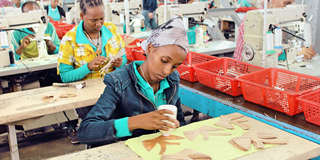Low-income African countries can sustain moderate rates of productivity growth into the future, on the back of steady improvements in human capital and governance. But the evidence suggests that, without manufacturing gains, the growth rates brought about recently by rapid structural change are exceptional and may not last.
CAMBRIDGE – Despite low world prices for the commodities on which they tend to depend, many of the world’s poorest economies have been doing well. Sub-Saharan Africa’s economic growth has slowed precipitously since 2015, but this reflects specific problems in three of its largest economies (Nigeria, Angola, and South Africa). Ethiopia, Côte d’Ivoire, Tanzania, Senegal, Burkina Faso, and Rwanda are all projected to achieve growth of 6% or higher this year. In Asia, the same is true of India, Myanmar, Bangladesh, Lao PDR, Cambodia, and Vietnam.
This is all good news, but it is also puzzling. Developing economies that manage to grow rapidly on a sustained basis without relying on natural-resource booms – as most of these countries have for a decade or more – typically do so through export-oriented industrialization. But few of these countries are experiencing much industrialization. The share of manufacturing in low-income Sub-Saharan countries is broadly stagnant – and in some cases declining. And despite much talk about “Make in India,” one of Prime Minister Narendra Modi’s catchphrases, the country shows little indication of rapid industrialization.
Manufacturing became a powerful escalator of economic development for low-income countries for three reasons. First, it was relatively easy to absorb technology from abroad and generate high-productivity jobs. Second, manufacturing jobs did not require much skill: farmers could be turned into production workers in factories with little investment in additional training. And, third, manufacturing demand was not constrained by low domestic incomes: production could expand virtually without limit, through exports.

CAMBRIDGE – Despite low world prices for the commodities on which they tend to depend, many of the world’s poorest economies have been doing well. Sub-Saharan Africa’s economic growth has slowed precipitously since 2015, but this reflects specific problems in three of its largest economies (Nigeria, Angola, and South Africa). Ethiopia, Côte d’Ivoire, Tanzania, Senegal, Burkina Faso, and Rwanda are all projected to achieve growth of 6% or higher this year. In Asia, the same is true of India, Myanmar, Bangladesh, Lao PDR, Cambodia, and Vietnam.
This is all good news, but it is also puzzling. Developing economies that manage to grow rapidly on a sustained basis without relying on natural-resource booms – as most of these countries have for a decade or more – typically do so through export-oriented industrialization. But few of these countries are experiencing much industrialization. The share of manufacturing in low-income Sub-Saharan countries is broadly stagnant – and in some cases declining. And despite much talk about “Make in India,” one of Prime Minister Narendra Modi’s catchphrases, the country shows little indication of rapid industrialization.
Manufacturing became a powerful escalator of economic development for low-income countries for three reasons. First, it was relatively easy to absorb technology from abroad and generate high-productivity jobs. Second, manufacturing jobs did not require much skill: farmers could be turned into production workers in factories with little investment in additional training. And, third, manufacturing demand was not constrained by low domestic incomes: production could expand virtually without limit, through exports.